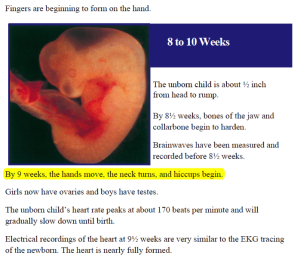Finding 1: While most statements were medically accurate, nearly one-third (31%) of statements were rated as “medically inaccurate.”
Examples of medical inaccuracies include the following: from week 2, “the head has formed” from week 4, “brain activity can be recorded” and from week 9, “hiccups begin”
Learn more about this finding…
Finding 2: “Medically inaccurate” statements were disproportionately concentrated in the first trimester of pregnancy and in the earliest weeks of pregnancy.
A total of 45 percent of statements about the first trimester were rated as medically inaccurate compared to 29 percent in the second trimester and 13 percent in the third trimester. Over 50 percent of statements in week 2 of pregnancy were found to be inaccurate, over 30 percent of statements in week 4 and 38 percent of statements in week 6 were rated as medically inaccurate.
Learn more about this finding…
 Finding 3: “Medically inaccurate” statements were disproportionately concentrated on particular body parts / systems / functions.
Finding 3: “Medically inaccurate” statements were disproportionately concentrated on particular body parts / systems / functions.
Experts found body systems that attribute human “intentionality” or more “baby-like” characteristics to the embryo or fetus, such as breathing, seeing, crying, or experiencing pain, were more likely to be misrepresented at earlier stages of development. Statements about limbs, fingers and toes, and nails were highly inaccurate. For example, “arm and leg buds are present” at week 2.

